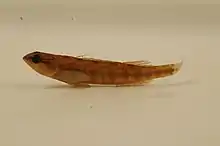Blackbanded darter
The blackbanded darter (Percina nigrofasciata) is a species of freshwater ray-finned fish, a darter from the subfamily Etheostomatinae, part of the family Percidae, which also contains the perches, ruffes and pikeperches. It is native to the river systems of the southeastern United States where it is found in the states of Tennessee, Georgia, Florida, Mississippi, Alabama, and Louisiana. It lives over sandy or gravelly bottoms in smaller rivers and streams and its color varies depending on the different habitats in which it lives. It feeds on small insect larvae and is itself preyed on by larger fish. It spawns between February and June depending on locality. It is generally a common fish throughout most of its range.
| Blackbanded darter | |
|---|---|
 | |
| Scientific classification | |
| Domain: | Eukaryota |
| Kingdom: | Animalia |
| Phylum: | Chordata |
| Class: | Actinopterygii |
| Order: | Perciformes |
| Family: | Percidae |
| Genus: | Percina |
| Species: | P. nigrofasciata |
| Binomial name | |
| Percina nigrofasciata (Agassiz, 1854 | |
Description
The body of the fish is variable and is influenced by the surrounding habitat. The blackbanded darter will be a light color if it is found along a sandy substrate. The darters that have a dark color are usually found around leaf litter, sticks, and aquatic vegetation. Breeding males have a greenish blue wash over their body and the head is brownish gold color.[2] The blackbanded darter can be confused with the dusky darter (Percina sciera).[2]
Distribution
The blackbanded darter inhabits many river systems in the United States. They are found in the Gulf of Mexico drainage in the southeastern United States (Tennessee, Georgia, Florida, Mississippi, Alabama, and Louisiana).[3] They can be found in the Choctawhatchee in Florida west to the western Mississippi River tributaries in Louisiana.[3]
Habitat and ecology
The blackbanded darter is found in headwaters to medium-sized rivers over gravel and sand substrates.[1] Blackbanded darters tend to live in intermediate microhabitat that has more erosional substrata and greater variety of depth.[4] Blackbanded darters are insectivores and feed on mayflies, midges, blackflies, caddisflies, or anything that is no larger than 5 mm (0.2 in) long.[5][6] The primary predators for the blackbanded darter are stonecats, largemouth bass, and other larger freshwater fish species.
Life history
The blackbanded darter spawns between February and June. Spawning occurs in sandy bottoms around a stream channel. The male approaches a female from the rear. Once on the female, he mounts her and beats her with his pelvic fin. The average clutch size for the blackbanded darter depends on the location. In Florida, a clutch size range from 4 to 73 eggs, while in Alabama, the range is from 38 to 250 eggs.[7] In Alabama, the sex ratio of the eggs favors male over females.[8] After the eggs are laid, there is no parental care. The life span of the blackbanded darter is estimated to be around three to four years. The life history of the blackbanded darter depends on geographic variation in environmental condition such as photoperiod and water temperature. Pollution and siltation can cause temperature change of the water which will affect when the darter will spawn.
Management
The blackbanded darter is not endangered or threatened in its range. They are listed as least concern.[9][10] In many areas of the southeastern United States where they inhabit, they are most abundant fish in river.
References
- NatureServe (2013). "Percina nigrofasciata". IUCN Red List of Threatened Species. 2013: e.T202585A18232298. doi:10.2305/IUCN.UK.2013-1.RLTS.T202585A18232298.en. Retrieved 19 November 2021.
- Blackbanded darter Archived August 5, 2013, at the Wayback Machine. 2008. Alabama Department of Conservation and Natural Resources. 17 November 2011.
- Hayes, MM, Piller, KR. Patterns of diversification in a North American endemic fish, the Blackbanded Darter (Perciformes, Percidae). Zool Scr. 2018; 47: 477– 485. doi:10.1111/zsc.12288
- Henry, BE. 2008. Microhabitat use by blackbanded (Percina nigrofasciata), turquoise (Etheostoma inscriptum), tessellated (E-olmstedi), darters during drought in Georgia Piedmont stream. Environmental Biology of Fishes 83:171–182.
- Rakocinski, C. 1991. Prey-size relationships and feeding tactics of primitive stream-dwelling darters. Canadian Journal of Fisheries and Aquatic Science 48:681–693.
- Mathur, D. 1973. Food habits and feeding chronology of black-banded darter, Percina nigrofasciata (Agassiz), in Halawakee Creek, Alabama. Transactions of the American Fishery Society 102:48–55.
- Mathur, D. 1973. Some aspects of life-history of blackbanded darter, Percina nigrofasciata (Agassiz) in Halawake Creek, Alabama. American Midland Naturalist 89:381–393.
- Hughey, MC. 2012. Variation in Reproductive life history between two populations of blackbanded darter (Percina nigrofasciata). Copeia 4:714–721.
- Percina nigrofasciata. The IUCN Red List of Threatening Species. 2013.
- http://www.fishbase.org/Summary/SpeciesSummary.php?ID=3500&AT=blackbanded+darter. Froese, R. and D. Pauly. 2011. Percina nigrofasciata. Fishbase. World Wide Web electronic publication. 2013.
